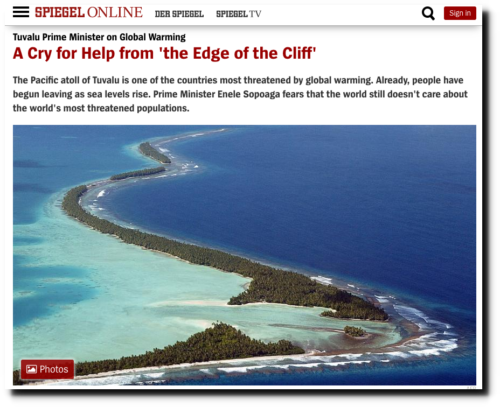Experts trash alarmist claims about sea level rise declaring: “The models have got it wrong and those who rely on the models have got it wrong.”
Paper Reviewed: Duvat, V.K.E., Salvar, B. and Salmon, C. 2017. Drivers of shoreline change in atoll reef islands of the Tuamotu Archipelago, French Polynesia. Global and Planetary Change 158: 134-154.
Writing as background for their study, Duvat et al. (2017) state that “it has commonly been considered that atoll reef islands would disappear under climate change, as a result of sea-level rise and induced accelerating shoreline erosion,” citing the works of Connell (2003), Dickinson (2009) and McAdam (2010).
This perception is based on model predictions, which have been hyped all over the globe, especially among politicians and the media, some of whom demand reparations for small island States who they fear will be forced to abandon their islands within decades.
But how much faith should one place in such projections and concerns?
According to Duvat et al., not that much; for as they write in the Introduction to their paper, “recent studies assessing shoreline change over the past decades to century have [now] proved atoll reef island persistence in the face of contemporary sea-level rise, therefore challenging the aforementioned generally accepted idea [of reef island demise due to climate change], citing the works of Webb and Kench (2010), Rankey (2011), Ford (2012; 2013), Biribo and Woodroffe (2013), Ford and Kench (2015), Kench et al. (2015), Testut et al. (2016) and Duvat and Pillet (2017).
And thanks to their newest work, the team of three French scientists increases the worldwide sample of atoll reef islands demonstrating this fact (from a shoreline change perspective) by a whopping 30%!
In achieving this important feat, Duvat et al. examined multiple aerial photographs and satellite images of 111 atoll reef islands from the Tuamotu Archipelago, French Polynesia to evaluate their persistence from a shoreline change perspective over the past half-century.
The end result of that examination is presented in the figure below.
As noted by the researchers, their findings bring “new irrefutable evidence on the persistence of reef islands over the last decades.”
Over the past three to five decades, the total net land area of the studied atolls “was found to be stable, with 77% of the sample islands maintaining their area, while 15% expanded and 8% contracted.”
Furthermore, they note that 7 out of the 8 islands that decreased in area were very small in area (less than 3 hectares), whereas “all of the 16 islands larger than 50 hectares were stable in area.”
Clearly, as summarily concluded by Duvat et al., atoll reef islands “are robust landforms.” They are not collectively in danger of drowning in the depths of the sea due to climate change.
The models have got it wrong and those who rely on the models have got it wrong. Nature is much more resilient than the alarmists make it out to be.
Figure 1. Change in island area per decade at the four study atolls. The 10 islands that formed, disappeared or merged during the timeframe of this analysis are not included in this graph. Island change within ± 3.0% (yellow band) is not considered significant, which means that islands in that group are regarded as being stable. Source: Duvat et al. (2017).
References
Biribo, N. and Woodroffe, C.D. 2013. Historical area and shoreline change of reef islands around Tarawa Atoll, Kiribati. Sustainability Science 8: 345-362.
Connell, J. 2003. Losing ground? Tuvalu, the greenhouse effect, and the garbage can. Asia Pacific Viewpoint 44: 89-106.
Dickinson, W.R. 2009. Pacific atoll living: how long already and until when? GSA Today 19: 124-132.
Duvat, V.K.E., and Pillet, V. 2017. Shoreline changes in reef islands of the Central Pacific: Takapoto Atoll, Northern Tuamotu, French Polynesia. Geomorphology 282: 96-118.
Ford, M. 2012. Shoreline changes on an urban atoll in the central Pacific Ocean: Majuro Atoll, Marshall Islands. Journal of Coastal Research 28: 11-22.
Ford, M. 2013. Shoreline changes interpreted from multi-temporal aerial photographs and high-resolution satellite images: Wotje Atoll, Marshall Islands. Remote Sensing of Environment 135: 130-140.
Ford, M.R., and Kench, P.S. 2015. Multi-decadal shoreline changes in response to sea level rise in the Marshall Islands. Anthropocene 11: 14-24.
Kench, P.S., Thompson, D., Ford, M.R., Ogawa, H. and McLean, R.F. 2015. Coral islands defy sea-level rise over the past century: Records from a central Pacific atoll. Geology 43: 515-518.
McAdam, J. 2010. ‘Disappearing states’ statelessness and the boundaries of international law. In: McAdam, J. (Ed.), Climate Change and Displacement: Multidisciplinary Perspectives, pp. 105-109 (Hart, Oxford).
Rankey, E.C. 2011. Nature and stability of atoll island shorelines: Gilbert Island chain, Kiribati, Equatorial Pacific. Sedimentology 58: 1831-1859.
Testut, L., Duvat, V., Ballu, V., Fernandes, R.M.S., Pouget, F., Salmon, C. and Dyment, J. 2016. Shoreline changes in a rising sea level context: The example of Grande Glorieuse, Scattered Islands, Western Indian Ocean. Acta Oecologica72: 110-119.
Webb, A.P. and Kench, P.S. 2010. The dynamic response of reef islands to sea-level rise: Evidence from multi-decadal analysis of island change in the Central Pacific. Global and Planetary Change 72: 234-246.
Read more at CO2 Science



















Remember Spiegel is the liberal German rag that spread the lies about the Hitler Diaries their just Americans version of TIME,Newsweek or Rolling Stone liberal leftists lies